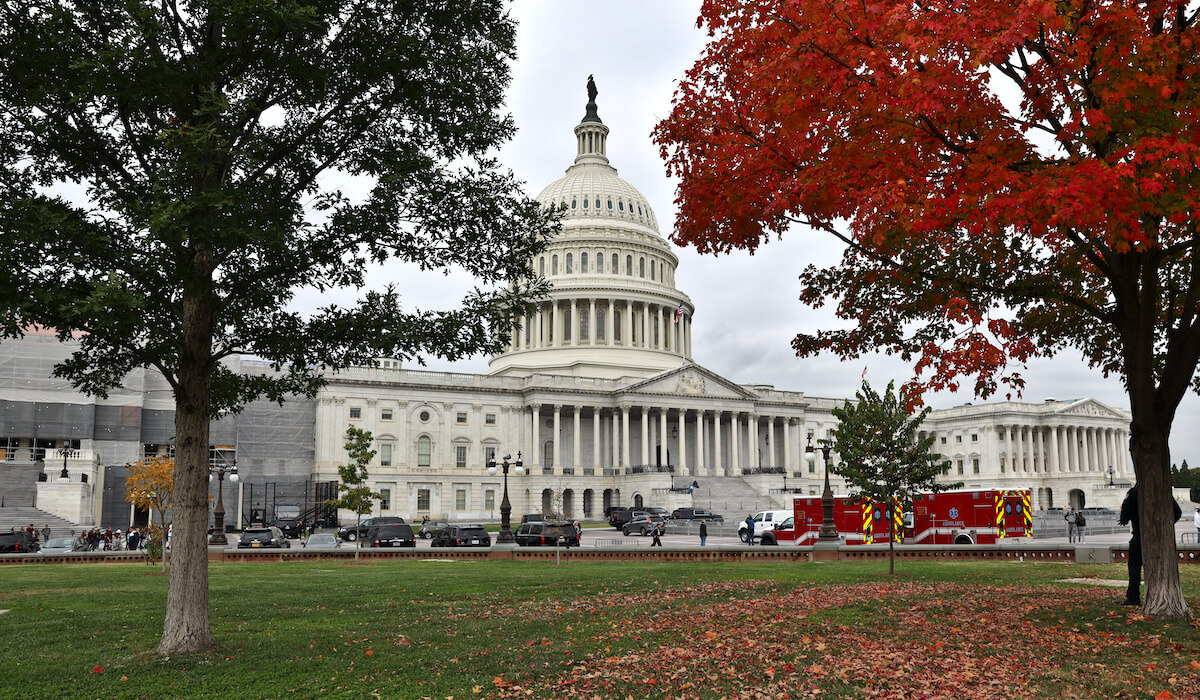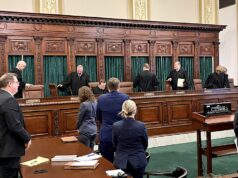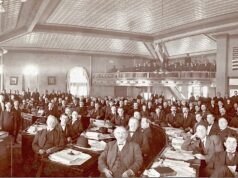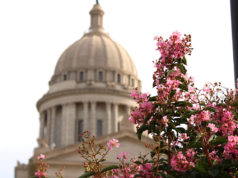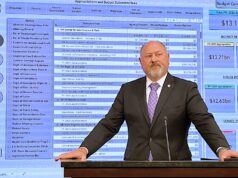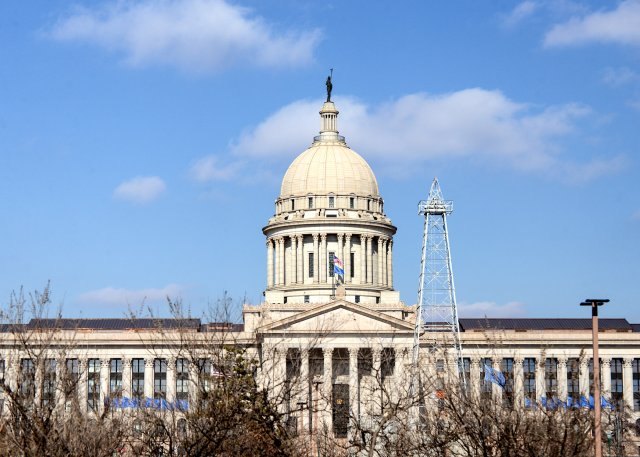

Leaders of the Oklahoma State Senate and House of Representatives announced a state budget agreement this afternoon that will increase the common education budget by $171 million, cut the individual income tax rate 0.25 percent, cut the corporate income tax rate 2 percent and deposit $800 million into state savings accounts.
While part of the education increase restores last year’s 2.5 percent cut, next fiscal year’s education funding hike includes additional money for textbooks and will result in capped class sizes for kindergarten and first grade in Oklahoma public schools.
“This is the most comprehensive budget that I’ve seen,” said House Speaker Charles McCall (R-Atoka). “There are historical investments in education in this budget, infrastructure in the state of Oklahoma, including broadband, which is an issue through the pandemic that we discovered is very much lacking in the state of Oklahoma.”
Although figures are still being finalized by legislative staff, the Fiscal Year 2022 budget deal arrived following a Wednesday night Senate GOP Caucus meeting and a lengthy Thursday morning House GOP Caucus discussion. After the House agreed to a revised and more straightforward tax reduction plan — straight rate cuts as opposed to a complex tax credit strategy — the top sticking point reportedly became an expansion of the Oklahoma Equal Opportunity Education Scholarship Program, which allows entities like the Opportunity Scholarship Fund to provide tax credits for donations to private and public schools.
At present, Oklahoma Equal Opportunity Education Scholarship Program tax credits are capped at $1,000 for individuals, $2,000 for married couples. Donors who give for one year to a qualifying organization receive a tax credit equal to 50 percent of the donation value. Those donating for two years receive a credit of 75 percent of their donation.
Currently, the program’s tax credits are statutorily capped at $3.5 million for private school donations and $1.5 million for public school donations. The legislative proposal that lawmakers are expected to take up in the coming days would raise both program caps to $25 million.
Budget-related bills are expected to be heard during Joint Committee on Appropriations and Budget meetings Friday morning. Lawmakers have until May 28 to pass a balanced state budget and adjourn the year’s regular session.
Negotiations between the House and Senate had grown tense over the past month as legislators disagreed on whether to trigger existing class-size cap statutes and how much money should be dedicated to a revamped film industry tax rebate.
“I’m very, very pleased with how this budget came together,” Gov. Kevin Stitt said. “I’m so proud that this budget also saves and puts back $800 million in savings and brings our savings accounts back over $1 billion.”
Asked how long it will take the Legislature to adjourn now that a budget deal has been announced, Stitt turned the question on lawmakers.
“Pretty darn quick after you sign the budget,” McCall said to laughter.
Education funding will trigger class-size cap

Ultimately, the announced budget deal increases funding for common education by $171.1 million. That level of increase will trigger a statute passed in SB 193 in 2019, which states kindergarten and first grade classes will be capped at 20 students, with a couple of caveats:
- The class cap will not apply if doing so would create an additional class of 10 or fewer students;
- An exemption also exists for certain classes employing a teacher’s aide.
The statutes impose the cap by stating that “no child shall be included in the average daily membership of a school district for the purpose of computing and paying state-appropriated funds if that child” is in a class that violates the above size limits.
The Oklahoma State Department of Education will receive a line item of $60 million for textbooks, a $27 million increase over the standard textbook appropriation. Lawmakers are also working to pass SB 229, which will provide marijuana-related tax revenue for brick-and-mortar charter schools and traditional public school districts that currently receive less aide.
“After such a very challenging year in the wake of the pandemic, the budget agreement announced today is tremendous news for students, teachers and, in fact, all Oklahomans who benefit from a strong educational system,” Superintendent of Public Instruction Joy Hofmeister said in a statement. “We are grateful to the House and Senate leadership and Gov. Stitt for this considerable investment in public education.”
Tax cuts come three years after historic tax hike
In February, McCall proposed reducing Oklahoma’s individual income tax burden and phasing out the corporate income tax over five years. But in early April, Senate President Pro Tempore Greg Treat (R-OKC) said his caucus had “no appetite” for the corporate income tax elimination proposal.
Asked what changed, Treat emphasized a preference for the direct tax cut mechanism instead of McCall’s proposed credit system, and he said the drop from 6 percent to 4 percent on the corporate income tax rate was preferable to a complete phase-out.
“Getting education reform, getting Medicaid paid for, everything is taken in context,” Treat said. “So a lot of moving parts had to happen in order us to get comfortable with that.”
McCall expressed pleasure with the compromise, which will include the restoration of the refundability of the earned income tax credit. That means some low-income working families will actually receive money from the state instead of paying income taxes.
“I didn’t get my version of the bill on either one of them, but at the end of the day we’ve come together to work in cooperation together with one another to make sure Oklahomans receive tax relief,” McCall said.
The tax cuts come only three sessions after lawmakers passed the largest tax increase in state history. In 2018, the Oklahoma Legislature achieved supermajority support for a $450 million revenue package that included increases on cigarette taxes, fuel taxes and the state’s oil and gas severance tax rate. The historic deal was necessary after slumping petroleum prices and a 2014 individual income tax cut combined to cause dramatic budget shortfalls.
Asked how this year’s income tax cuts will not set the state up for similarly perilous times, legislative leaders said Oklahoma’s economy has proven to be stronger and more diversified.
“At the end of the day we respond to every crisis that faces the state of Oklahoma,” McCall said. “At the end and close of this fiscal year, I think we are in a much, much better fiscal position than we were five years ago when we were facing revenue raisers to correct a fiscal crisis in the state. We don’t want to return to that place.”
McCall said the three legs of the State Capitol’s proverbial stool all agreed “the tax relief needs to happen this year.”
“Those (tax rates) will require a three-quarter vote sometime in the future if they are ever to be returned,” McCall said. “However, I’m optimistic that if we continue to invest in the right things in the state of Oklahoma going forward, we will expand our economy. We will see more dollars, more business, more people (…) You’re going to be able to keep more of your earnings. We know what happens when people and businesses have more money in their pocket, they spend it.”
Some groups, such as House and Senate Democrats and the Oklahoma Policy Institute, have argued that tax cut bills should require a three-fourths majority because tax increases require that level of support.
“We always have to be mindful of the situations and what could happen in the future, but by far, I believe in the state of Oklahoma our trajectory is very strong, very positive, and I believe these tax relief measures are necessary,” McCall said. “The timing is perfect and they are going to benefit everyone in the state of Oklahoma.”
Senate Appropriations and Budget Chairman Roger Thompson (R-Okemah) said the estimate for the annual impact to state revenues from the corporate income tax rate reduction will be about $110 million. He said the estimate for the individual income tax rate reduction from 5 percent to 4.75 percent will be about $170 million a year.
House Appropriations and Budget Chairman Kevin Wallace (R-Wellston) said five states have no corporate income tax. Among those that do, Oklahoma will now have the third-lowest rate.
“This is going to help us retain corporations here in Oklahoma and also attract new corporate headquarters to the state of Oklahoma,” Stitt said.
Wallace said Oklahoma will now have an individual income tax rate among the 10 lowest in the country.
Follow @NonDocMedia on:
Film rebate reimagined to grow state industry
For weeks, House Republican leaders maintained that they were opposed to an expansion of the state’s tax rebate program for film production unless the Senate would approve tax reductions.
With the budget deal announced today, the Senate agreed to tax reductions, and the House agreed to a $30 million rebate for a revised film tax rebate program, which will provide greater benefits to productions based on how much filming is done in the state. The Senate had originally sought $50 million, but the House had amended the proposal to $20 million. Ultimately, the two chambers found a number in between.
“It’s all about Oklahoma companies. It’s a workforce bill as well. They will be using apprentices in the filmmaking,” said Thompson, the primary proponent of SB 608. “But in two years, the rebate will only apply to Oklahoma companies using Oklahoma employees. You’re not going to be able to bring in out-of-state companies.”
Hospital SHOPP fee to increase over three years
Thompson and Wallace said the state’s portion of Medicaid expansion — expected to cost about $164 million a year for the coverage of low-income adults — will largely be paid for with surplus federal dollars when it begins July 1.
RELATED
Oklahoma getting ‘a significant amount’ more in Medicaid money from federal relief bills by Tres Savage
Beyond that, the state’s Supplemental Hospital Offset Payment Program will be increased from 2.5 percent to 3 percent, and then to 3.5 percent and 4 percent over the next two years.
Thompson said that will yield an additional $37 million this year, $89 million next year and $135 million the following year.
Private general hospitals already participate in SHOPP by paying the Oklahoma Health Care Authority a fee that helps the agency qualify for additional federal dollars to pay for the state’s existing Medicaid populations, including children, pregnant women, disabled individuals and low-income parents.
Under Oklahoma law, critical access hospitals — a federal designation for eligible rural facilities — are exempt from making SHOPP payments to the Oklahoma Health Care Authority, which operates the state’s Medicaid program, also called SoonerCare.
According to 2018 numbers, at least 40 rural hospitals in Oklahoma have the critical access designation. State hospitals, federal hospitals, tribal hospitals, specialty hospitals, children’s hospitals and long-term care hospitals are also exempt from making SHOPP payments.
That means the majority of new SHOPP dollars would also be paid by urban and suburban hospitals.
Other agency budgets, line items see increases
Many state agencies that received a roughly 4 percent cut during last year’s economic uncertainty will see those cuts restored, and then some. A document showing preliminary agency allocations is embedded below.
Individual appropriation items of note include:
- $800 million to the state’s constitutional and statutory savings accounts;
- $9.9 million for an in-patient pediatric behavior health unit at OU Health;
- $12.5 million for a reconstruction of the mental health services and addiction treatment fund created by State Question 781;
- $10.4 million for endowed chairmanships at colleges and universities;
- $42 million for broadband expansion as a sales tax rebate;
- $2 million to help address the state’s development disabilities services waiting list;
- $10.5 million for the state’s higher education system to emphasize workforce development of engineers, nursing and teachers;
- $4.3 million to help regional and two-year higher education institutions with maintenance and operations.
While the document below shows dramatic increases or decreases for a handful of agencies, those variations typically reflect a change in one-time spending. For instance, the Oklahoma State Election Board received additional funding last year to prepare for coronavirus mitigation at polling places during the 2020 election cycle. This year, the Department of Mental Health and Substance Abuse Services’ appropriation appears lower, but that reflects Medicaid dollars now directed to the Oklahoma Health Care Authority.
 Loading...
Loading...
Democratic leaders expressed frustration with not receiving details of the budget deal earlier.
“Regarding the transparency, the very first budget numbers we saw were at 11 o’clock this morning,” said Senate Minority Leader Kay Floyd (D-OKC).
House Minority Leader Emily Virgin (D-Norman) tweeted that her caucus never received a presentation of the numbers at all prior to Thursday’s press conference.
“Budgets are a product of the priorities of their authors. Both Democrats and Republicans proposed tax cuts this week. Republicans focused on lowering the tax burden on corporations, while House Democrats focused on working Oklahomans and their families,” Virgin said in a statement. “Both Democrats and Republicans proposed savings. Democrats called for more than $300 million in savings, while Republicans called for $800 million. While an extra $500 million in savings sounds nice, our citizens are literally paying the price. With this money, we could end the state sales tax on groceries, which would save Oklahomans more than $250 million per year.”
Virgin also panned the proposal to increase the Equal Opportunity Education Scholarship Program cap.
“Finally, we can not in good conscience vote for any budget that sends $25 million of hard-earned taxpayer money to private schools,” she said.
Budget deal to restore many FY 2021 cuts
Last year, lawmakers and Stitt feuded over how much the state budget should be cut amid falling revenue estimates and economic uncertainty caused by the pandemic and crashing oil prices. Lawmakers approved a Fiscal Year 2021 budget $237 million (3 percent) lower than the previous year. Most state agencies received a 4 percent cut, with common education receiving a 2.5 percent cut. Stitt vetoed the budget and called for deeper cuts, but the Legislature overrode his veto.
More information about past state budget deals
(Correction: This article was updated at 9:30 a.m. Friday, May 14, to correct reference to the Oklahoma Equal Opportunity Education Scholarship Program.)








